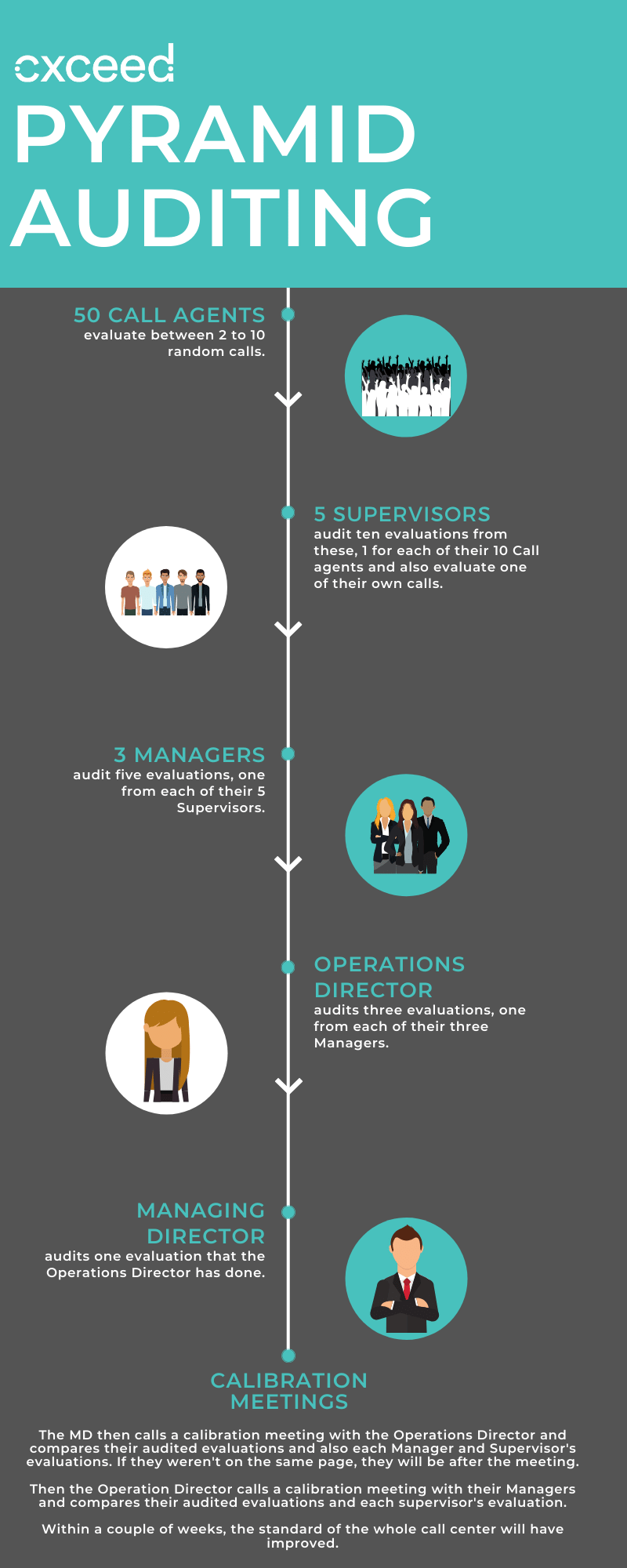Software Quality Assurance for Contact Centers
What is Software Quality Assurance?
QA (Quality Assurance) Software measures and facilitates the improvement of business processes, products, services, or actions.
The overall aim is to make sure that a product or service is produced to a specific standard, guaranteeing a level of quality.
There are two types of QA software: manufacturing or product-based, and services-based businesses.
The need to have a section of a machine that interacts with other parts in a specific way is obvious - how would it work properly if not?
A piston that isn't manufactured to the correct size might still fit into an engine block, but it won't make a combustion engine run smoothly.
In service-based businesses, it is a common misconception that QA is just for Call Centers. In reality, every company has more than one process that can benefit from it.
What are the Benefits of Quality Assurance?
Integrated correctly, software quality assurance can drastically help service-based companies progress, increasing their profitability, staff motivation, communication skills, and training effectiveness. Not only this, but it can help reduce employee defensiveness to feedback as well as the staff turnover your organization experiences.
This article will focus on QA software for service-based companies, specifically the four areas that QA software can help you get the results you want in: Customer Feedback, Training, Staff Turnover, and Calibration.
I'll be listing the various software available including our competitors, but I will also be referring to Cxceed a lot in this article, so sorry about that, but we've worked hard to make it what it is today. We want to show it off!
Software Quality Assurance for Service Businesses
Benchmarking Customer Experience (CX)
Chances are, if you're a business, you sell (if you don't, you won't be a business for long)
So, who do you sell or provide a service to? Customers, clients, end-users whatever you want to call them, the fact remains - without them, you struggle.Your customers want to feel special so you need to make sure they do by improving their customer experience (CX).
The first step to improving the customer service you provide is discovering how well you are currently doing. It doesn't matter how good you think you are; it's your Clients opinion about their Customer Experiences when dealing with your company that matters.
To find this out Cxceed sends out Surveys to your Clients, the replies are then scored and this score is then used as a benchmark that you can measure future scores against. Benchmark are usually repeated every 3-6 months.
If your current survey score is higher than your last one you're on the right path! If it's lower, you need to have a rethink. Want to focus on specific areas of your business? No problem! You can customize your surveys to match your needs.
Getting Immediate Customer Feedback
Sending the occasional survey out is not enough. From my experience, requesting feedback after interacting with customers is highly effective. By doing so, you find out what they did and didn't like about that specific interaction through the answers they provide.
By asking for feedback, you're showing the customer that you care about the quality of service you deliver and that their opinion matters to you. You're also signaling to them that you want to improve the service you provide to them.
I know some companies may be afraid of bothering the customer by asking for feedback, but they shouldn't. If someone doesn't want to fill out a feedback form, they won't, and if they do they will, no-one is forcing them to (hopefully)!
In practice, most customers will only fill in the feedback requests when they are either very happy or very unhappy with the service you provide. Coincidently this is just the type of information from your customers that you need to improve your business.

Improving the Effectiveness of Training
“Half the money I spend on advertising is wasted; the trouble is I don't know which half.” - John Wanamaker, Department Store pioneer (United States).
Apologies to John Wanamaker, but I've co-opted his famous quote and changed it a little.
“Over half the money you spend on training is wasted; the trouble is you don't know which half.” - Duncan Horsfall, MD Cxceed (United Kingdom).
I nearly quoted the 80/20 rule, but I'm not confident that all companies are wasting as much as 80% of their training budgets, but I know a lot are.
Employees often find training courses boring and quickly switch off. Why? Because they are not focussed on what they as an individual need to improve or learn. How can you improve your employees if you don't know what they're doing well and what they're doing badly?
I've tried it before and you can't do it effectively. You waste a lot of time and money retraining them on things they already know.
A good QA software program should identify what needs improving, not just in the organization as a whole but on an individual level. This enables a company to personalize and customize their training to each individual, no matter how many people an organization has.
The ability to mark interactions and save them for later is also a useful feature. These communications can then be given to old and new employees to analyze and evaluate. This can help prepare staff for the kind of issues they may have to deal with, while also showing them the dos and don'ts.
The best examples to learn off are real ones - Ain't nothing like the real thing, baby!
Evaluating, Analysing and Improving
If you're able to spot the best and worst interactions, then you can understand what needs to be improved.
OK, let's be honest here. I don't like evaluating /analyzing Phone calls, product demos, or re-reading employee emails. Reviewing lots of calls to find great or problem ones can be like listening for your Gran's voice in a packed football stadium. Difficult.
But I realize that it has to be done. Why? Because done right, it produces results. Not just minor improvements but groundbreaking seismic change.
So if I have to do it, I want it to be as pain-free as possible.

Here's How We Do it at Cxceed
1: Filter the calls by customer feedback score, so you spend your time listening to calls that have either impressed or left your customers unimpressed.
2: Make the process easy; when you select a call to evaluate, your phone rings, and when you answer, the recording plays into your phone, and an evaluation form appears on your screen.
3: Leverage our employees; Instead of our managers pointing out where employees are going wrong, we encourage everybody to self-evaluate their own interactions.
Why does self-evaluation work?
We've all been there when a manager criticizes you. It can be horrible, and your self-defense barriers rise. You don't want to listen because you think you're right.
But, if an employee can find their own mistakes, they can do so without feeling judged. I know if I find my errors, I'm a lot more likely to make sure it doesn't happen again!
The employees can also peer evaluate their colleague's interactions. By encouraging employees to learn from each other, advice can be given in a friendly manner.
What are you Looking for When Evaluating?
The short answer is doesn't matter if it is a service call, a sales call, an email, or a letter, I'm looking for EFFORT. I want our staff to delight our customers.
I need to know that they have taken the time to understand what the customer wants and tried to provide it for them.
This is a big question and I will provide the long answer on a separate blog.
In our business, we try to evaluate everything because we know that everything we evaluate, we find a way to improve.
This continual improvement delights our customers, which in turn drives the company forward.
Calibration
When you first begin to use software quality assurance, there will be a lot of variation in the scores your agents give for the same communication. But that's okay; it shows you made a good investment!
It is important though to get everyone pulling in the same direction, so the aim of Calibration is to ensure that interactions are being evaluated in the same way across an organization.
Leading a company is difficult; setting objectives, designing strategies that generate goodwill, build sales, and maximize revenue and profitability are all difficult tasks.
For me, though, the hardest task has always been to get our staff to not just buy into the company vision but to implement it on a day to day basis. To get them to do what you want them to do and to say what you want them to say in the way you want them to say it.
The larger a business is, and the more employees it has, the harder it is for the senior management to influence the way their employees do their jobs.
Calibration is an essential tool in the battle to make sure the whole company is following the vision and company values set by senior management.
Calibration sessions can be held to help guide employees on how to evaluate a call and to compare evaluations between staff. These sessions promote transparency, making it easier for staff to accept feedback and improve. The aim is to ensure everyone understands what makes a good and bad phone call, email, etc. Once everybody understands what is expected, you can achieve consistency throughout your organization!
You need to expect more from your software.

The Answer is to Leverage your Time Using Pyramid Auditing!
Depending on their experience level, each one of the 50 call agents evaluates between 2 to 10 random calls.
5 Supervisors then audit ten evaluations from these, 1 for each of their 10 Call agents and also evaluates one of their own calls.
3 Managers audit five evaluations, one from each of their 5 Supervisors.
The Operations Director audits three evaluations, one from each of their three managers.
The Managing Director audits one evaluation that the Operations Director has done.
The MD then calls a calibration meeting with the Operations Director and compares their audited evaluations and also each Manager and Supervisor's evaluations. If they weren't on the same page, they will be after the meeting.
Then the Operation Director calls a calibration meeting with their Managers and compares their audited evaluations and each supervisor's evaluation.
Within a couple of weeks, the standard of the whole call center will have improved.
Here's that information made into a handly graphic for you to take away!

Reducing Your Staff Turnover
Attracting the right people, training them, teaching them to convert opportunities, how to close a sale and delight your customers is expensive. So it makes financial sense to try and minimize staff turnover to just the people you want to leave.
Software quality assurance implemented into your day-to-day operations helps to improve staff training, we've already established that.
When employees are trained well, they perform their job better and make your customers happier; it's a simple equation. Staff performing at the top of their game are undoubtedly happier in their working environment.
Happy employees don't want to leave. They usually want to work harder for their company and help strive for success.
If you can reduce your staff turnover, your business will start to gel together. Not only do you reduce your hiring and training costs, but employees will have a better understanding of the company and provide a better customer experience to your customers.
Customers who frequently contact an organization often prefer to build up a relationship with one employee. Strong relationship building will only increase the loyalty and lifetime value of your customers.
QA not only helps you retain your experienced staff but also train new starters quicker.
Try it For Yourself!
Improve Your Business Today
Discover how Cxceed can help improve your customer experience, and boost your profit.


